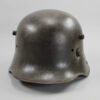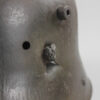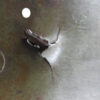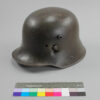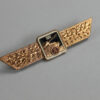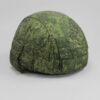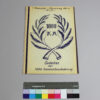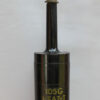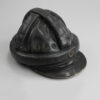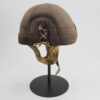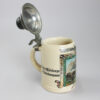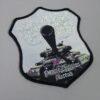M16 steel helmet with artillery shrapnel
Inventory number: DPM 1.987
More than nine million soldiers died in the First World War, over two million of them Germans. Many more were injured. It is estimated that 2.7 million physically and mentally wounded soldiers were living in Germany at the end of the war. The wearer of this helmet was lucky: a piece of artillery got stuck in his steel helmet. He survived and kept the helmet as a memento.
By 1917, almost half of the soldiers in trench warfare had died from head injuries, mostly caused by fragments from artillery shells. Both shrapnel shells, which hurled small metal balls at the soldiers when detonated, and explosive grenades, which shattered into a particularly large number of small, sharp-edged pieces, were used. Due to their high velocity, they could also penetrate bone. Even the smallest fragments were extremely dangerous and could cause severe brain damage. The leather helmet with a spike, also known as a Pickelhaube, which was commonly used in Germany, offered no protection against them. France was the first belligerent state to issue steel head protection for its soldiers in February 1915, followed by Germany a year later. The first examples were issued to German troops at Verdun at the beginning of 1916.
A total of 7.5 million steel helmets were manufactured in Germany. They were made of chrome-nickel steel with silicon added. As a result, the material was able to withstand small splinters and shrapnel bullets. The helmet was not bulletproof, but its rounded shape could deflect bullets in a favorable situation. The helmet was designed to protect the entire brain area with a deep neck guard, a small front shield and deep-drawn sides. The German engineer Friedrich Schwerd designed the shape, which was already iconic at the time, taking into account the requirements of the military doctor August Bier.
Despite all the advantages, not all soldiers were given a steel helmet by the end of the war in 1918, but rather those deployed at the front. After the capitulation of the German Reich, masses of military equipment and weapons were to be delivered to the Allies or destroyed. Some of the steel helmets were later used to equip the Reichwehr. However, many soldiers took their steel helmets home with them after the war and kept them as a symbol of their service on the front and as a memento.
This text was automatically translated using AI.
Object of the month
(short) stories from the depot
Unfortunately, many objects cannot currently be shown in the exhibition for conservation reasons. Here you will find unusual objects and exciting stories of special pieces from the depot

